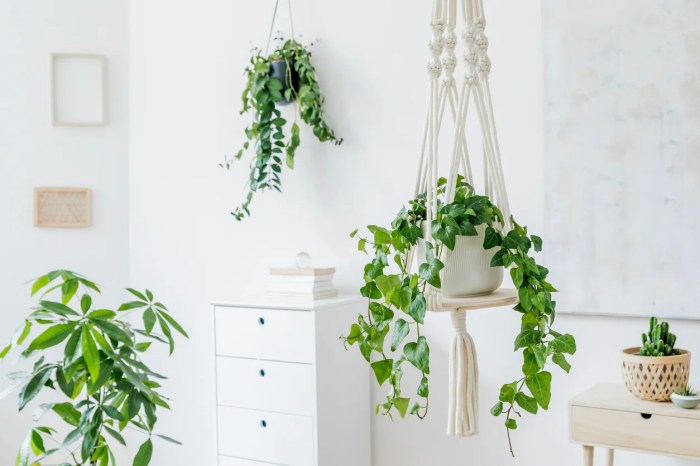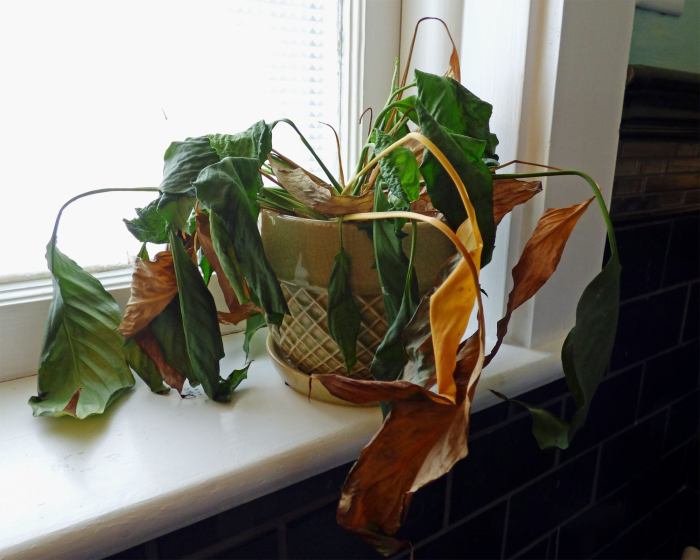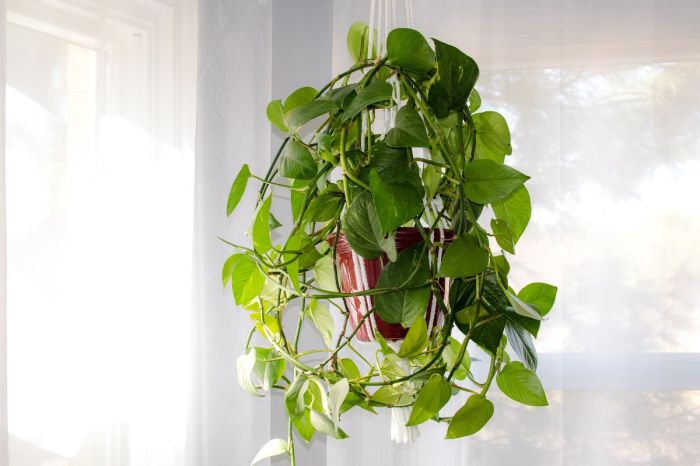Why do hanging plants die? This common question plagues plant enthusiasts and novice gardeners alike. Understanding the reasons behind hanging plant demise is crucial for maintaining thriving indoor greenery. This comprehensive guide delves into the environmental, nutritional, and other factors that contribute to the decline of hanging plants, empowering readers with the knowledge to prevent and remedy these issues.
From insufficient light to improper watering and nutrient deficiencies, various factors can lead to the demise of hanging plants. Identifying and addressing these challenges is essential for ensuring the longevity and beauty of these indoor wonders.
Environmental Factors
Environmental factors play a crucial role in the health and survival of hanging plants. Understanding these factors and providing appropriate care can significantly improve their chances of thriving.
Insufficient Light
Hanging plants often receive less light than their counterparts on the ground. Insufficient light can hinder photosynthesis, the process by which plants convert sunlight into energy. This can lead to stunted growth, yellowing leaves, and eventually plant death.
Improper Watering
Both overwatering and underwatering can harm hanging plants. Overwatering can suffocate the roots and promote root rot, while underwatering can cause the plant to wilt and dry out. It’s essential to water hanging plants when the soil is slightly dry to the touch.
Hanging plants can suffer from various issues that lead to their demise, including insufficient light, incorrect watering, and pests. However, for those looking to add some greenery to their indoor space, hanging devils ivy bunnings is a popular choice due to its resilience and ability to thrive in various conditions.
Nonetheless, understanding the common reasons why hanging plants die remains crucial to ensure their longevity and prevent premature wilting.
Temperature Fluctuations and Humidity
Hanging plants are sensitive to extreme temperature fluctuations and humidity levels. Sudden changes in temperature can shock the plant and cause leaf drop. Low humidity levels can lead to dry, brittle leaves, while high humidity levels can promote fungal growth.
Nutrient Deficiencies

Hanging plants rely on a balanced supply of nutrients for optimal growth and vitality. Deficiencies in essential nutrients can lead to yellowing leaves, stunted growth, and eventually, plant death.
Essential nutrients for plant growth include nitrogen, phosphorus, potassium, calcium, magnesium, and sulfur. Each nutrient plays a specific role in plant physiology and metabolism.
Nitrogen Deficiency
Nitrogen is crucial for photosynthesis, the process by which plants convert sunlight into energy. Nitrogen deficiency leads to stunted growth, yellowing leaves, and reduced flower production.
Phosphorus Deficiency
Phosphorus is essential for root development, energy storage, and seed production. Phosphorus deficiency causes stunted growth, poor root development, and delayed flowering.
Potassium Deficiency
Potassium regulates water uptake, photosynthesis, and starch production. Potassium deficiency results in yellowing leaves, stunted growth, and reduced fruit quality.
Soil pH
Soil pH affects nutrient availability. Most hanging plants prefer slightly acidic to neutral soil pH (6.0-7.0). In acidic soils, nutrients like phosphorus and iron become more available, while in alkaline soils, nutrients like calcium and magnesium become less available.
Pest and Disease Issues

Hanging plants, with their lush foliage and cascading vines, can be a beautiful addition to any home. However, these plants can also be susceptible to a variety of pests and diseases that can quickly lead to their decline.Common pests that can infest hanging plants include aphids, spider mites, and mealybugs.
Aphids are small, soft-bodied insects that feed on plant sap, causing leaves to become discolored and distorted. Spider mites are tiny, eight-legged creatures that spin webs on the undersides of leaves, causing them to turn yellow and drop off. Mealybugs are small, white insects that feed on plant sap, leaving behind a sticky residue.Hanging
plants can also be affected by a variety of diseases, including root rot, powdery mildew, and botrytis. Root rot is caused by a fungus that attacks the roots of the plant, causing them to rot and the plant to wilt and die.
Powdery mildew is a fungal disease that causes a white powdery growth on the leaves of the plant. Botrytis is a fungal disease that causes gray mold to grow on the leaves and flowers of the plant.It is important to regularly inspect hanging plants for signs of pests and diseases.
If pests or diseases are found, it is important to treat them promptly to prevent them from spreading and causing further damage.
The reasons why hanging plants die are complex and vary depending on the plant species, environment, and care practices. To prevent these unfortunate occurrences, consider using Bunnings wall hanging pots , which provide ample drainage and air circulation to help keep your plants healthy and thriving.
Despite these measures, if your hanging plants continue to perish, it’s crucial to investigate the underlying causes to determine the best course of action.
Pests
Aphids, spider mites, and mealybugs are the most common pests that can infest hanging plants. These pests can cause a variety of symptoms, including:
- Discolored or distorted leaves
- Yellowing and dropping leaves
- Sticky residue on leaves
If you find any of these pests on your hanging plants, it is important to treat them promptly. There are a variety of insecticides available that can be used to control these pests.
Diseases
Hanging plants can also be affected by a variety of diseases, including root rot, powdery mildew, and botrytis. These diseases can cause a variety of symptoms, including:
- Wilting and dying plants
- White powdery growth on leaves
- Gray mold on leaves and flowers
If you find any of these diseases on your hanging plants, it is important to treat them promptly. There are a variety of fungicides available that can be used to control these diseases.
Hanging Basket Considerations
Hanging plants face unique challenges due to their growth environment. Their suspended position can lead to improper drainage and aeration, which can contribute to plant death. Additionally, the size and material of the hanging basket can impact plant health.
Drainage and Aeration, Why do hanging plants die
Proper drainage is crucial for hanging plants. Excess water can accumulate at the bottom of the basket, leading to root rot and other problems. Choose a hanging basket with drainage holes to allow excess water to escape. Additionally, ensure the potting mix is well-draining to prevent waterlogging.
Adequate aeration is also essential. Roots need oxygen to thrive. Hanging baskets can restrict airflow, especially if they are made of solid materials like plastic or metal. Opt for hanging baskets with openwork designs or use liners made of breathable materials like fabric or mesh to improve aeration.
Basket Size and Material
The size of the hanging basket should be appropriate for the plant’s root system. A too-small basket will restrict root growth, while a too-large basket can lead to overwatering and nutrient deficiencies. Choose a basket that is large enough to accommodate the plant’s root ball but not excessively spacious.
The material of the hanging basket can also impact plant health. Plastic baskets are lightweight and durable but can retain heat and moisture, which can be detrimental to plants. Metal baskets are more durable but can rust and leach harmful chemicals into the soil.
Choose baskets made of breathable materials like wicker, fabric, or wood to promote optimal plant growth.
Plant Selection and Care

Hanging plants add a touch of greenery and life to indoor spaces, but they can be prone to death if not properly cared for. Selecting the right plants and providing adequate care are crucial for their survival.
When choosing hanging plants, consider the light conditions, humidity, and temperature of the indoor environment. Some plants, such as ferns and spider plants, thrive in low-light conditions, while others, like succulents and cacti, prefer brighter light. It’s also essential to select plants that can tolerate the humidity levels in the room.
Watering is crucial for hanging plants. Overwatering can lead to root rot, while underwatering can cause the plant to wilt and die. The frequency of watering will depend on the type of plant, the size of the pot, and the humidity of the environment.
Fertilization is another important aspect of hanging plant care. Fertilizing provides essential nutrients for healthy growth. Use a balanced fertilizer diluted to half strength and fertilize monthly during the growing season.
Hanging plants can die due to various factors, including incorrect watering, insufficient light, or inadequate drainage. To address these issues, consider using plant basket bunnings , which provide proper drainage and airflow, reducing the risk of overwatering and root rot.
However, it’s essential to address the underlying causes of plant death, such as providing optimal light conditions and adjusting watering frequency.
Pruning is also beneficial for hanging plants. Regular pruning helps to remove dead or damaged leaves, promote new growth, and maintain the desired shape of the plant.
By following these care tips, you can keep your hanging plants healthy and thriving for years to come.
Early Signs of Plant Stress or Disease
Early detection of plant stress or disease is crucial for timely intervention and prevention of further damage. Here are some signs to watch for:
- Discolored leaves (yellowing, browning, or spotting)
- Wilting or drooping leaves
- Stunted growth
- Leaf loss
- Insect infestations
If you notice any of these signs, inspect the plant closely to identify the cause and take appropriate action, such as adjusting watering, fertilizing, or treating for pests or diseases.
Wrap-Up

By understanding the causes of hanging plant death and implementing the appropriate solutions, plant enthusiasts can create thriving indoor oases. With proper care and attention, hanging plants can bring a touch of nature and beauty to any space, adding vibrancy and life to homes and offices.
Question Bank: Why Do Hanging Plants Die
What are the common environmental factors that can lead to hanging plant death?
Insufficient light, improper watering (overwatering or underwatering), and fluctuations in temperature and humidity can all contribute to the decline of hanging plants.
What nutrient deficiencies can cause hanging plants to die?
Nitrogen, phosphorus, and potassium deficiencies are common nutrient imbalances that can lead to yellowing leaves, stunted growth, and eventually plant death.
How does improper drainage and aeration affect hanging plants?
Hanging plants require proper drainage to prevent waterlogging and root rot. Inadequate aeration can also hinder root development and overall plant health.